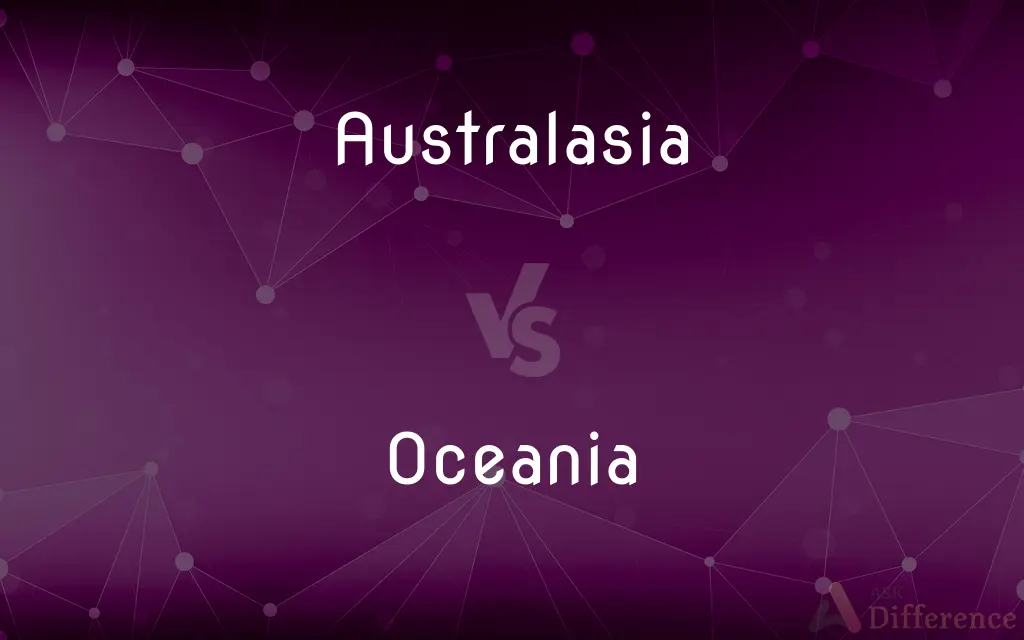Australasia vs. Oceania — What's the Difference?
Edited by Tayyaba Rehman — By Urooj Arif — Updated on February 29, 2024
Australasia encompasses Australia, New Zealand, and neighboring islands within Pacific, focusing on geological connections. Oceania is a broader term that includes all Pacific islands, Australia, and New Zealand, emphasizing geographical links.

Difference Between Australasia and Oceania
Table of Contents
ADVERTISEMENT
Key Differences
Australasia is a region that primarily includes Australia, New Zealand, and Papua New Guinea, along with adjacent islands. It's often considered in contexts relating to geology, flora, and fauna, highlighting the biological and geological similarities and connections among these areas. Oceania, on the other hand, is a more expansive concept that not only encompasses the territories included in Australasia but also extends to encompass three subregions: Melanesia, Micronesia, and Polynesia. This classification is broader, including a vast number of islands across the central and south Pacific Ocean.
This region is recognized for its distinct ecosystems, such as the Australian Outback and the unique wildlife of New Zealand. Oceania is frequently used in geopolitical and cultural discussions, reflecting the diverse cultures, languages, and histories of its inhabitants.
The distinction between Australasia and Oceania is significant in various fields of study. In biology and geology, Australasia denotes a region with shared natural history characteristics, especially notable in the unique wildlife and plant life of Australia and New Zealand. In contrast, discussions about Oceania often address cultural, social, and political aspects, acknowledging the rich diversity among the islands and peoples of the Pacific.
Australasia has a more specific focus, highlighting the landmasses of Australia and New Zealand along with nearby islands, Oceania's definition brings together a vast array of islands spread over a significant portion of the Earth's surface. This includes not only the geographical spread but also the immense cultural and linguistic diversity found within its boundaries.
Understanding the nuances between Australasia and Oceania is essential for accurate communication and analysis in fields ranging from geography and ecology to anthropology and international relations. The terms encapsulate different aspects of the region's identity, from its environmental characteristics to its cultural and historical complexities.
ADVERTISEMENT
Comparison Chart
Composition
Australia, New Zealand, Papua New Guinea, and nearby islands
Australia, New Zealand, Melanesia, Micronesia, Polynesia
Focus
Geological and biological connections
Geographical and cultural links
Usage
In contexts of geology, flora, and fauna
In geopolitical and cultural discussions
Recognized For
Unique ecosystems and wildlife
Cultural and linguistic diversity
Coverage
More specific, focusing on a closer group of territories
Broader, encompassing a wide range of Pacific islands
Compare with Definitions
Australasia
Region including Australia and New Zealand.
Australasia is known for its unique species like the kangaroo and kiwi.
Oceania
Broad region including Pacific islands, Australia, and New Zealand.
Oceania encompasses a diverse range of cultures and languages.
Australasia
Highlights distinct ecosystems.
Australasia's ecosystems, like the Great Barrier Reef, are globally significant.
Oceania
Covers a vast area of the Pacific.
Oceania's islands extend from Southeast Asia to the central and south Pacific.
Australasia
Focused on biological and geological connections.
The geological history of Australasia reveals ancient land bridges.
Oceania
Divided into Melanesia, Micronesia, and Polynesia.
Oceania's subregions reflect the geographical spread of its islands.
Australasia
Encompasses adjacent Pacific islands.
Islands near Australia and New Zealand are considered part of Australasia.
Oceania
Known for cultural and linguistic diversity.
Oceania is home to hundreds of indigenous languages and cultures.
Australasia
Pertains to a specific geographical area.
Conservation efforts in Australasia focus on protecting native habitats.
Oceania
Focuses on geographical and cultural links.
The cultural practices of Oceania are studied to understand human migration patterns.
Australasia
Australasia is a region which comprises Australia, New Zealand, and some neighbouring islands. The term is used in a number of different contexts including geopolitically, physiogeographically, and ecologically where the term covers several slightly different but related regions.
Oceania
Oceania (UK: , US: (listen), ) is a geographic region that includes Australasia, Melanesia, Micronesia and Polynesia. Spanning the Eastern and Western Hemispheres, Oceania has a land area of 8,525,989 square kilometres (3,291,903 sq mi) and a population of over 41 million.
Australasia
Australia, New Zealand, and neighboring islands in the South Pacific
Oceania
A large group of islands in the south Pacific sometimes including Australasia and the Malay Archipelago.
Common Curiosities
Why is the distinction between Australasia and Oceania important?
The distinction is important for accurate geographical, biological, and cultural understanding and discussions about the regions.
How do Australasia and Oceania differ?
The main difference lies in their scope and focus; Australasia is more specific, while Oceania is broader and includes a greater emphasis on cultural diversity.
What defines Australasia?
Australasia is defined by a group of countries and islands, primarily Australia, New Zealand, and Papua New Guinea, focusing on their geological and biological connections.
What is Oceania?
Oceania is a broad region that includes all Pacific islands, Australia, and New Zealand, emphasizing geographical and cultural links.
What is unique about Australasia's wildlife?
Australasia's wildlife, including species like kangaroos and kiwis, is unique due to the region's long geographical isolation.
How does geography affect the regions of Australasia and Oceania?
Geography shapes the environmental, cultural, and historical identity of both regions, influencing biodiversity in Australasia and cultural diversity in Oceania.
What is the significance of Papua New Guinea in Australasia?
Papua New Guinea is significant for its shared geological and biological history with Australia and New Zealand, contributing to the region's biodiversity.
Can the terms Australasia and Oceania be used interchangeably?
While related, they should not be used interchangeably due to their different scopes and emphases.
What cultural diversity exists in Oceania?
Oceania is home to a vast array of cultures and languages, with significant diversity found in its many islands and peoples.
How do the islands of Oceania differ from each other?
The islands vary in terms of geography, from high volcanic islands to low-lying atolls, and in culture, with diverse languages, traditions, and histories.
Share Your Discovery
Previous Comparison
Beacon vs. Lighthouse
Next Comparison
Score vs. ObtainAuthor Spotlight
Written by
Urooj ArifUrooj is a skilled content writer at Ask Difference, known for her exceptional ability to simplify complex topics into engaging and informative content. With a passion for research and a flair for clear, concise writing, she consistently delivers articles that resonate with our diverse audience.
Edited by
Tayyaba RehmanTayyaba Rehman is a distinguished writer, currently serving as a primary contributor to askdifference.com. As a researcher in semantics and etymology, Tayyaba's passion for the complexity of languages and their distinctions has found a perfect home on the platform. Tayyaba delves into the intricacies of language, distinguishing between commonly confused words and phrases, thereby providing clarity for readers worldwide.
















































